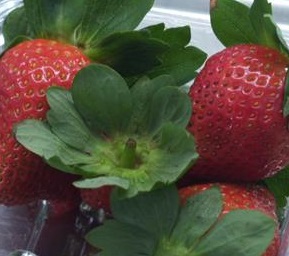 Fruit must be picked often as soon as it is ripe otherwise you
can encourage botrytis (fungal rot) – strawberries very quickly develop
fungal rot once over-ripe. Harvesting every second day is a good rule of
thumb. Fruit must be picked often as soon as it is ripe otherwise you
can encourage botrytis (fungal rot) – strawberries very quickly develop
fungal rot once over-ripe. Harvesting every second day is a good rule of
thumb.- Ripe fruit of the common strawberry is red all over
when ripe – this is when the berry has the most sugar content and is
also the tastiest. If you pick at this stage (and most home growers
would) then handle fruit carefully when harvesting – it means that they
will keep longer when no bruised or damaged.
- Make sure that the fruit is dry when you harvest it – this prevents rotting after harvest.
- Harvesting
in mid-morning if possible (warm climates) through to the middle of the
day (cooler areas) is a good approach as this is when the fruit is at
its best and tastiest.
- Harvest fruit by gently: Slightly
twist and then pull the stalks, just above the strawberry (about 1cm).
Some varieties are easier to harvest than others if the twist and pull
motion does not remove the fruit easily then try nipping between your
thumb and fingernail of your fore-finger. Although not the commercial
approach you can also pick the berries without the calyx attached – but
take care though as berries will easily bruise if you don’t do this
correctly: firmly hold the stem, directly behind the cup of the calyx,
between your thumb and forefinger and give the cap a slight squeeze
whilst at the same time slightly pushing the berry with your fore-finger
– the berry should pull easily away from the calyx.
- Not
all strawberries will be on the surface of the plant so part the leaves
to ensure that you have picked all the ripe fruit all the way around the
plant and under the leaves.
- Gently place the fruit in a
container as you harvest them; professional pickers do so using both
hands and holding (without squashing) up to 4 fruit in each hand before
placing them in the container. Make sure that the container is out of
the sun or your fruit may spoil.
- Overfilling containers when you harvest will cause bruising – use containers no more than 10cm-12.5cm deep to prevent bruising.
- Remove
all rotten and damaged fruit as you see them to prevent spread of
fungal disease. Have another container handy for this purpose so you can
easily dispose of the damaged fruit.
- Cool the fruit as soon as possible after harvest – fruit will keep for about 3 days refrigerated.
|
Latest
Categories
Archive
|